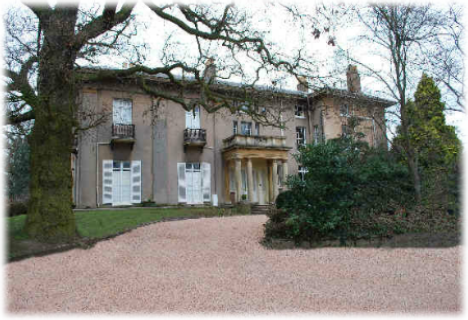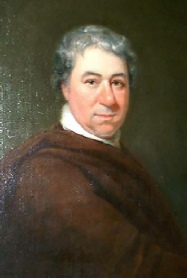FRIENDS OF CLAINES CHuRCH
JOHN RUSSELL
Iron and Coal Master 1796-
Worcestershire, Gloucestershire and Monmouthsire
By Peter Verity
John Russell was a self made man born in Worcestershire in 1796. He married at St John the Baptist, Claines, Worcestershire 1st May 1817, Mary daughter of Benjamin and Mary Downs of Alton Court, Herefordshire, (she was baptised at Orleton, 18th Sept 1796). He was reputedly looked down on by the family of Mary Downs to whom he is said to have vowed ‘that his wife would always have a carriage and pair’.
John Russell developed considerable industrial interests especially in South Wales, it was said that ’all he touched turned to gold’. He was owner of The Worcester Pipe Works and The Risca Coal and Iron Joint Co and Russell’s Brickworks. In 1836 John Russell and Co bought Waunfawr Colliery with a site covering 1000 acres and in 1841 John Russell had a new shaft of 559 ft sunk at Coed Waunfawr (Blackvein). In 1842 John Russell and Co were awarded the contracts to provide the steam coal to the East India Company, Peninsular and Orient Company as well as The Royal West Indian Steam Packet Company.
Russell was a partner with Thomas Brown in the Blaina Iron Works which they took over in 1839 and the Cwmtillery Colliery which he took over in 1852. In 1853 he sank a new shaft of 785ft and was shipping 350 tons of coal a week from Cwmtillery, this is in contrast to the very evocative description he wrote of the way of life on the farm of Tir Nicholas which had existed in 1850 prior to his development of the colliery. In 1858 he sank a further shaft and 1864 he incorporated Cwmtillery into his South Wales Colliery Company.
Other interests of John Russell included iron workings in the Forest of Dean, The Monmouthshire Railway and Canal Company and he was active with Sir Charles Morgan (Lord Tredegar) in the development of the port at Newport. He is also associated with the development of Coalbrookdale at Madely in Shropshire. His son John Richard Russell was to marry Maria Francis the daughter of Sir Hugh Owen baronet of Orielton and Angelina Morgan sister of Lord Tredegar.
During the development of his South Wales interests it would seem that he moved between Terhill House at Cheltenham, Risca House, and The Wyelands at Chepstow, until 1856 when after several years of having leased Piercefield, the neighbouring estate to Wylands he acquired the Piercefield Estate. (The record indicates that he retained 27 servants to run Piercefield). During this period, much to the annoyance of the townspeople of Chepstow, he restricted access to the park.
John Russell was made a Justice of the Peace in 1842, High Sheriff of Monmouthshire in 1855 and at the time of his death was one of the oldest magistrates in Monmouthshire. His London house, at 28 Westbourne Park, was burgled by the infamous murder Chas Peace who was disturbed in his work and left behind a silver tea pot which he had flattened for ease of removal. (Russell’s great grandson Noel Kynaston (Hookey) Gaskell wrote ‘The Romantic Career of a Great Criminal’, A Life of Charles Pearce, 1906)
In the development of his South Wales industrial interests Russell was in partnership with, George Randle Hookey of Risca House, (who on 30 June 1840, in the presence of Mary Anne and Jane Russell, was married at Risca Parish Church to Russell’s daughter Susanna) and who in 1842 gave evidence to the Enquiry on the Employment of Children in Mines.
Russell’s colliery interests seem to have been plagued by a series of disasters and loss of life (it was said that his collieries were so prone to accidents that he had to bring men from Somerset, Dorset, Gloucestershire and Wiltshire to work for him). In 1846 a gas explosion at the Risca Blackvein Colliery killed thirty five men, in 1849 two men where killed and in 1853 ten men lost there lives in a gas explosion. The worst of the disasters occurred on the 1st December 1860 when there was a major explosion in which one hundred and forty six men died. Though working with naked lights had been banned, only a week before the explosion a collier had been convicted and fined by the local magistrates for the use of a naked light underground in breach of the regulations.
The Risca Blackvein disaster was a great human and a severe financial loss. The Risca Colliery Company was bankrupted by the explosion and by the cost of a legal battle with Lord Tredegar over encroachment on other rights, George Randle Hookey lost everything. In 1861, to establish a trust for the miner’s families, Russell sold Piercefield and returned to Terhill House in Gloucestershire. By 1866 the Blackvein Colliery had been sold to Thomas Rhodes.
In 1867 John Russell acquired the estates of Badgeworth Court at Churchdown, Gloucestershire from J Viner Ellis; he died in 1873 and is commemorated by the great east window at Badgeworth parish church, though he was buried at St Clement’s at the heart of his Worcester estate. Mary Downs died at Terhill in 1878 and was buried with her husband at St Clements Worcester.
John Russells four daughters were educated at “Oaklands School” in Claines
John Russells Children:
- Mary Anne: married Henry Maudsley (believed a son of Henry Maudsley (Maudslay) the great mechanic and originator of modern machine tools -
Maudsley, Sons and Field 1810 - with which Russell may well have had business connections) - Susanna: married 30 June 1840 at the Parish Church of Risca, George Randle Hookey (1808-
1877) of Worcestershire, son of George Hookey and Anne Gaskell, (lived at Risca House, after the disaster at Furze Hall, Fryening Essex. and later in Cheltenham). Children: George John Hookey (1842- 1896) married Constance Emily Verity Cox and Henry Gaskell Hookey married 1879 his cousin Agnes Maud Cleather (see Burke’s L.G 1906 Gaskell of Churchdown). - Ellen Harriet: married Col. John Handcock Selwyn Payne (1822 -
1880), son of Charles Payne, Mayor of Bristol, (inherited Badgeworth, Gloucestershire, see Burkes L.G.) son Richard, daughter Maud Albina, Lady Cunynghame (see Burke’s P.B). - Jane: married Rev. George Ellis Cleather -
daughter Agnes Maud married Henry Gaskell Gaskell second son of George Randle Hookey (see Burke’s L.G 1909 Gaskell of Churchdown). - John Richard Russell: JP, born Worcestershire 1831, (lived at The Lodge, Risca, Monmouthshire and Halden House, High Halden, Kent). Captain in the Monmouthshire Malitia. Married Maria Francis Owen daughter of Sir Hugh Owen baronet of Orielton and Angelina Maria Cecilla Morgan sister of Sir Charles Morgan, Lord Tredigar, seven children, died London 1887
References:
- Shropshire Archeological Society, iv 92; Downs of Alton Court
- History of the Verity Family, Vol 2. Glamorgan Records Office. D/D Xcb4/1-
6. Under Constance Russell Hookey (Verity). - Shropshire Archives Re Hookey. Ref:5411/171/14
- Jones, Alan Victor. Risca: It’s Industrial and Social Development. ISBN08611
- Trinder , Industrial Revolution of Salop 1981 p155
- Gloucestershire Records Office. D1421/12
- Gwent Records Office. Ref: D394. D591. D797.415
- Walters, Ivor. Piercefield on the Banks of the Wye. F.G. Comber.1975
- Records held by Sonia Pether (nee David).
- Portrait, collection Julian Verity. Picture of Piercefield (as designed by John Soane) belonging to Peter Verity.
- www.welshcoalmines.co.uk >Collieries >Gwent >Risca Blackvein > John Russell here
- Worcester Records Office. Manor of Guesten, Worcester. Ref: 705:477 BA4120/37/1. Dec1854 John Russell of Wyelands and Mesuages in St Clements Parish, Worcester
- Notes and photograph on Oaklands/Oakfields House by Geoff Sansome, Claines Friends, with reference to Claines 1851 Census.
Oaklands School refers to the House now known as “Oakfields”, just off the Droitwich Road and now the home of the River School.
In the 1851 Census this was known as “Oakfields Academy” and was obviously a school for well to do young ladies. There were 9 teachers in residence and 35 girls aged from 8 to 18 years old, supported by five servants. The School Mistress was one Mary Marmont, aged 66, from Wales. The Census shows that the girls came from far and wide, their birth places including the counties of Lancashire, Hertfordshire, Rutlandshire as well as Dublin, India and Nova Scotia. The teachers were equally cosmopolitan, with birth places which included Havannah, Florence and Hanover.
All of the 54 who lived and worked at Oakfields were single and female with the exception of one 13 year old boy servant George Evans!

Oakfield’s House, Claines, today



